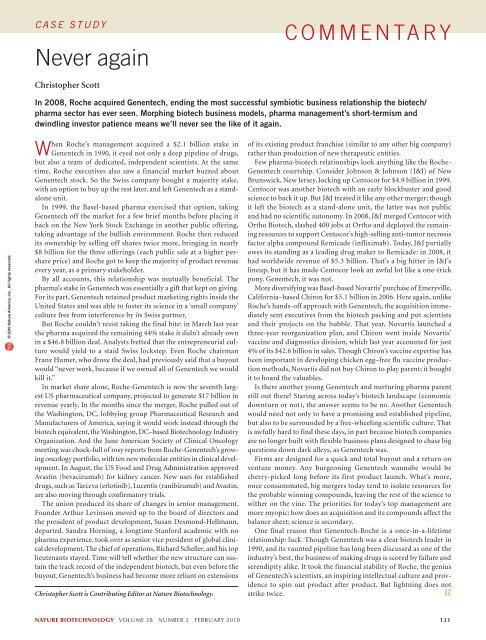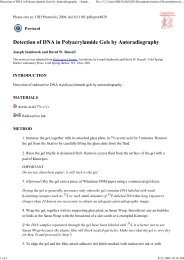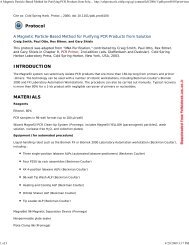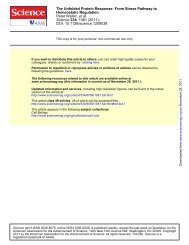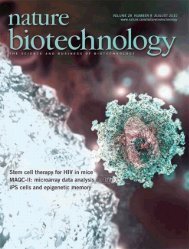Ontology engineering
Ontology engineering
Ontology engineering
Create successful ePaper yourself
Turn your PDF publications into a flip-book with our unique Google optimized e-Paper software.
case studyNever againcommentaryChristopher ScottIn 2008, Roche acquired Genentech, ending the most successful symbiotic business relationship the biotech/pharma sector has ever seen. Morphing biotech business models, pharma management’s short-termism anddwindling investor patience means we’ll never see the like of it again.© 2010 Nature America, Inc. All rights reserved.When Roche’s management acquired a $2.1 billion stake inGenentech in 1990, it eyed not only a deep pipeline of drugs,but also a team of dedicated, independent scientists. At the sametime, Roche executives also saw a financial market buzzed aboutGenentech stock. So the Swiss company bought a majority stake,with an option to buy up the rest later, and left Genentech as a standaloneunit.In 1999, the Basel-based pharma exercised that option, takingGenentech off the market for a few brief months before placing itback on the New York Stock Exchange in another public offering,taking advantage of the bullish environment. Roche then reducedits ownership by selling off shares twice more, bringing in nearly$8 billion for the three offerings (each public sale at a higher pershareprice) and Roche got to keep the majority of product revenueevery year, as a primary stakeholder.By all accounts, this relationship was mutually beneficial. Thepharma’s stake in Genentech was essentially a gift that kept on giving.For its part, Genentech retained product marketing rights inside theUnited States and was able to foster its science in a ‘small company’culture free from interference by its Swiss partner.But Roche couldn’t resist taking the final bite: in March last yearthe pharma acquired the remaining 44% stake it didn’t already ownin a $46.8 billion deal. Analysts fretted that the entrepreneurial culturewould yield to a staid Swiss lockstep. Even Roche chairmanFranz Humer, who drove the deal, had previously said that a buyoutwould “never work, because if we owned all of Genentech we wouldkill it.”In market share alone, Roche-Genentech is now the seventh largestUS pharmaceutical company, projected to generate $17 billion inrevenue yearly. In the months since the merger, Roche pulled out ofthe Washington, DC, lobbying group Pharmaceutical Research andManufacturers of America, saying it would work instead through thebiotech equivalent, the Washington, DC–based Biotechnology IndustryOrganization. And the June American Society of Clinical Oncologymeeting was chock-full of rosy reports from Roche-Genentech’s growingoncology portfolio, with ten new molecular entities in clinical development.In August, the US Food and Drug Administration approvedAvastin (bevacizumab) for kidney cancer. New uses for establisheddrugs, such as Tarceva (erlotinib), Lucentis (ranibizumab) and Avastin,are also moving through confirmatory trials.The union produced its share of changes in senior management.Founder Arthur Levinson moved up to the board of directors andthe president of product development, Susan Desmond-Hellmann,departed. Sandra Horning, a longtime Stanford academic with nopharma experience, took over as senior vice president of global clinicaldevelopment. The chief of operations, Richard Scheller, and his toplieutenants stayed. Time will tell whether the new structure can sustainthe track record of the independent biotech, but even before thebuyout, Genentech’s business had become more reliant on extensionsChristopher Scott is Contributing Editor at Nature Biotechnology.of its existing product franchise (similar to any other big company)rather than production of new therapeutic entities.Few pharma-biotech relationships look anything like the Roche-Genentech courtship. Consider Johnson & Johnson (J&J) of NewBrunswick, New Jersey, locking up Centocor for $4.9 billion in 1999.Centocor was another biotech with an early blockbuster and goodscience to back it up. But J&J treated it like any other merger; thoughit left the biotech as a stand-alone unit, the latter was not publicand had no scientific autonomy. In 2008, J&J merged Centocor withOrtho Biotech, slashed 400 jobs at Ortho and deployed the remainingresources to support Centocor’s high-selling anti-tumor necrosisfactor alpha compound Remicade (infliximab). Today, J&J partiallyowes its standing as a leading drug maker to Remicade: in 2008, ithad worldwide revenue of $5.3 billion. That’s a big hitter in J&J’slineup, but it has made Centocor look an awful lot like a one-trickpony. Genentech, it was not.More diversifying was Basel-based Novartis’ purchase of Emeryville,California–based Chiron for $5.1 billion in 2006. Here again, unlikeRoche’s hands-off approach with Genentech, the acquisition immediatelysent executives from the biotech packing and put scientistsand their projects on the bubble. That year, Novartis launched athree-year reorganization plan, and Chiron went inside Novartis’vaccine and diagnostics division, which last year accounted for just4% of its $42.6 billion in sales. Though Chiron’s vaccine expertise hasbeen important in developing chicken egg–free flu vaccine productionmethods, Novartis did not buy Chiron to play parent; it boughtit to hoard the valuables.Is there another young Genentech and nurturing pharma parentstill out there? Staring across today’s biotech landscape (economicdownturn or not), the answer seems to be no. Another Genentechwould need not only to have a promising and established pipeline,but also to be surrounded by a free-wheeling scientific culture. Thatis awfully hard to find these days, in part because biotech companiesare no longer built with flexible business plans designed to chase bigquestions down dark alleys, as Genentech was.Firms are designed for a quick and total buyout and a return onventure money. Any burgeoning Genentech wannabe would becherry-picked long before its first product launch. What’s more,once consummated, big mergers today tend to isolate resources forthe probable winning compounds, leaving the rest of the science towither on the vine. The priorities for today’s top management aremore myopic: how does an acquisition and its compounds affect thebalance sheet; science is secondary.One final reason that Genentech-Roche is a once-in-a-lifetimerelationship: luck. Though Genentech was a clear biotech leader in1990, and its vaunted pipeline has long been discussed as one of theindustry’s best, the business of making drugs is scored by failure andserendipity alike. It took the financial stability of Roche, the geniusof Genentech’s scientists, an inspiring intellectual culture and providenceto spin out product after product. But lightning does notstrike twice.nature biotechnology volume 28 number 2 february 2010 131


